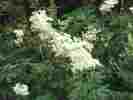| As you wander the trail the number of
beautiful plants growing amongst the old workings will surprise you.
In the shorter coastal turf are the purple heads of the northern marsh orchid, one of 9 different species of orchid that grow in Caithness. Common blue butterflies looking for sites to lay their eggs visit vetches such as the yellow birds foot trefoil and black medick. Northern Marsh Orchid Taller herbs such as Meadow sweet and Angelica grow in the shelter of the walls. On still days the air is full of the distinctly sweet smell of the flower and it was used as an air freshener in days gone by when it was strewn on the floors of dwelling places. It was also an important medicinal plant being used in the treatment of arthritis and migraine. In the shady walls of the works pits grows Harts tongue fern. This lime loving plant is uncommon this far north and it thrives on the lime released by the old mortar. |
Meadowsweet  From the trail look across the bay towards Dunnet Head, the most
northerly point of mainland Scotland. Its cliffs of Devonian aged old
red sandstone rise to 70 metres. The same rock type can be found in
Orkney to which it was at one time joined. From the trail look across the bay towards Dunnet Head, the most
northerly point of mainland Scotland. Its cliffs of Devonian aged old
red sandstone rise to 70 metres. The same rock type can be found in
Orkney to which it was at one time joined.Behind the waters of the bay lies one of the most extensive dune systems in Scotland. It is eroding and being undercut by rising sea levels and the blowouts are constantly being fashioned by the wind. Sand from these dunes has blown onto the links inland to form an area rich in flowering plants containing rarities such as the Scottish primrose. |
| Dunlin
The waters of the bay provide feeding for a varied bird life. In summer it is possible to see tern wheeling and screeching amongst the gulls and the brown and white great skuas (known locally as bonxies) patrolling for easy food. Eider duck guddle around the rocky shores often with ducklings as they forage for crabs. |
| Swallow
In late summer the old houses roofs provide roosts for large
gatherings of swallow and house martin and the thistles feed small
flocks of goldfinch |
| Red Throated Diver
In late summer there is also a good chance of seeing porpoise in the bay as they move around the coast following the mackerel and there are also the two species of whales to be seen. For more plants in Caithness - See Ken Butlers Botanical List |